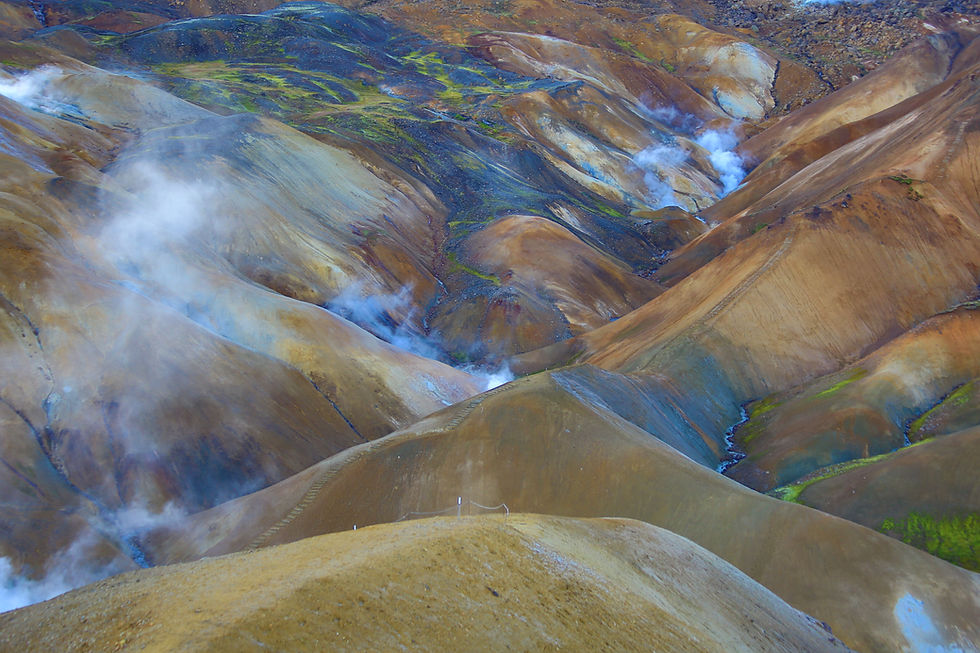Olympic National Park, Washington
- Jul 4, 2021
- 3 min read
Updated: Aug 17, 2023

From the air (or from google map), the box-shaped Olympic Peninsula, was created 35 millions ago from plate tectonics. As the oceanic Farallon Plate subducted under the North American Plate, parts of the Farallon Plate was scraped off and bit by bit it piled up under the sea floor. As the seafloor was uplifted, it created a huge mountainous dome, and overtime, the heavy glaciation period carved it into what we see today; the snowcapped Olympic Mountains with it's highest peak at 7,962" called Mt. Olympus. With the amount of rain the Pacific Northwest gets annually, the peninsula and the Olympic Mountains is rich with glaciers; its the most prominent of them all is the Blue Glacier. However, even with the amount of rain it gets, the glaciers are shrinking at an alarming rate. At its lower elevations, the ground is covered with mossy forest, and therefore, this area harbors one of the largest temperate rainforests in the world. Many visitors come here to trek this diverse biome, starting from the Pacific Ocean, crossing a huge swath of temperate rainforests dripping with moisture, and finally topping out at the Blue Glacier, just short of Mount Olympus.

We started our journey to see the Olympic Mountains from north Seattle, taking the scenic route to Edmonds Ferry. It a relatively quicker than driving around the sound, and of course less of a drive when taking a ferry across the Puget Sound. The ferry ride from Edmonds to Kingston is but just around 20 minutes on the water, and in all it took about 30 minutes to get across. The ride was very smooth on the Walla Walla ferry, which is rated to carry about 196 cars and 2000 passengers.
From Kingston, it was a pleasant drive on to Port Angeles. The port itself is a small shipping town with just two main streets. Many would stop here to do a last fill-up or pick-up of food before heading up to Hurricane Ridge.
The drive up to Hurricane Ridge is about 17 miles long. It is a meandering mountain road will beautiful views of the Bailey Range all the way to the top. When we drove along the Hurricane Ridge Road, there were still crews cleaning up certain rockfall areas along the way. We also paid our entrance fee of USD $30, at the temporary ranger booth. It looked like they were making improvements to build a more permanent visitor gate/entrance; which would be a nice addition to the park.
Once we arrived at Hurricane Ridge at 5242', the lot was not full and there were Black Tail Deer grazing along the field. The visitor center was open and there were rangers giving out information to the many visitors. Its an amazing yet often taken for granted sight, as to what it takes to create such infrastructure out in the middle of the wilderness. It was just in 2020 that the national parks upgraded the septic processing for Hurricane ridge. With its approximately 2.5 to 3.39 million visitors each year, its no wonder that the visitor center needed an upgrade.

We promptly parked our car near the trailhead to Sunrise Ridge Trail, as we were going to hike to Mount Angeles. We figured that we needed to make good time as most of the trail is exposed and the day we hiked was one of the hottest days (over 100 degrees F) experienced in the Pacific Northwest. It was so hot that we packed the melting snow under our caps to keep our heads cool!

The trail was relatively busy at the start, but as we approached Mount Angeles, there were fewer hikers, till finally, it was only just us on the mountain. The trail was beautiful. Well graded and not too difficult at all. There was only one steep section down into the saddle before the base of Mount Angeles where there is a junction to the Switchback Trail, and one steep rise to the meadow before the rock scrambles at the top of the mountain.
There were many rolling hills which reminded us of the Sound of Music(!) It was easy to imagine Julie Andrews running down the green hill belting out, "The hills are alive, with the sound of music...!" Everywhere one looked, there were snowcapped mountains, pine trees, and the occasional remaining snow.
Unfortunately, we were just 450 feet short of the top of Mount Angeles. Having been cooked by the sun and low on water, we decided not to climb further as the views from where we were was already amazing.
The hike back to Hurricane Ridge was just as good as on our way over. There were plenty of wild flowers and the continuous view of the Bailey Range with its snowcapped mountains. We could also see Olympus and the Blue Glacier. Just magnificent! For the full video of this hike click here.
























Comments